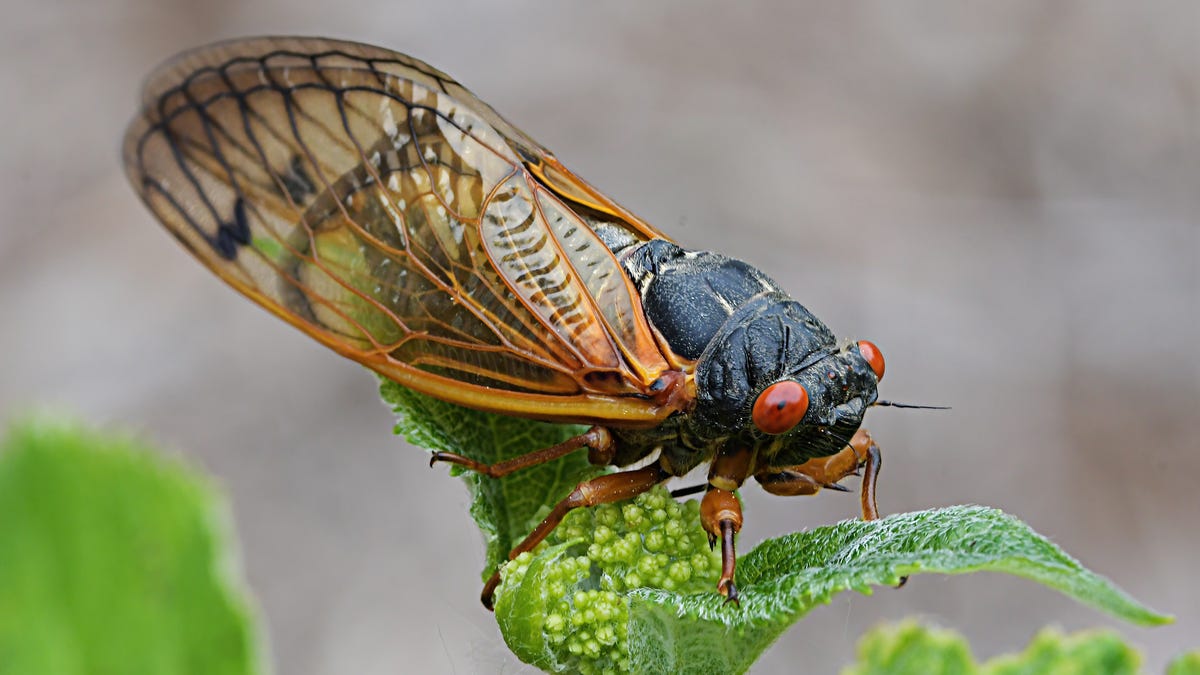Technologies
Cicadas Are Coming, and So Are the Cicada Salad Recipes
Twice the cicada buzz is due in 2024, and some people are already seeing signs of the winged critters. Here come the recipes.

Hungry? Hungry enough to eat a cicada salad? The Audubon Insectarium in New Orleans is prepping for «cicada-geddon» by testing out some buggy recipes. The Associated Press reports that the museum is trying out cicada recipes, including a green salad with apple, almonds and blueberry vinaigrette, with fried cicada nymphs scattered on top.
Recipes or not, the noisy cicadas are about to hit many parts of the US, and some people are already reporting seeing the loud winged insects. Early visitors are already here. One Reddit user in Missouri shared a photo of cicada nymphs beginning to dig their way out from underground from beneath a plastic pool. And in Chicago, residents are organizing a citywide, summer-long art project called Cicada Parade-a, featuring cicada sculptures.
Cicadas have a weird life cycle. They grow underground, but we humans mostly pay attention to them when they emerge into our above-ground world. And this year is a doozy for the buzzy little guys — in an Associated Press story, University of Connecticut cicada expert John Cooley called it «cicada-geddon.»
There are annual cicadas, which emerge from their underground life every year at various times. Then there are periodical cicadas, which emerge only every 13 or 17 years. Those groupings are called broods and are numbered. Because of their trackable schedule, these broods of periodical cicadas tend to steal all the headlines from their annual cicada comrades.
This summer, it’s a double-brood year. That’s rare. According to ScienceAlert, the last time it happened was in 1803. One brood on a 13-year cycle — called Brood XIX — and another on a 17-year cycle — called Brood XIII — are expected to pop out of the ground in 2024.
Here’s what to know before they take over your neighborhood between May and June, including how to protect your hearing from all that cicada noise — and whether climate change could be responsible for be disrupting the cicada cycle.
What’s expected in 2024
Brood XIX
Brood XIX, also called the Great Southern Brood, is the biggest brood of 13-year periodical cicadas, if you go by geographical distribution. It was last seen in 2011 in the Southeast US. Most periodical cicadas are on a 17-year cycle, but Brood XIX is on a 13-year cycle. The two other surviving 13-year broods are expected to return in 2027 and 2028.
This brood is expected to re-emerge in mid-May and stay around through late June. The cicadas tunnel to the surface, mate, lay their eggs and then die off. Look (and listen) for them in Alabama, Arkansas, Georgia, Illinois, Indiana, Kentucky, Louisiana, Mississippi, Missouri, North Carolina, Oklahoma, South Carolina, Tennessee and Virginia.
Brood XIII
Brood XIII is known as the Northern Illinois Brood. Illinois seems to appeal to cicadas more than any other state. Experts at the University of Connecticut say that the Land of Lincoln «contains both 13- and 17-year life cycles, all seven currently recognized species, and five separate broods, some of which include disjunct populations.» Talk about the Big Noise from Illinois.
This is one of the 17-year cicada broods. It was last seen in 2007 and should be back from mid-May to late June, just like Brood XIX. They are expected to appear in Illinois, Indiana, Iowa, Wisconsin and possibly Michigan.
The basics about cicadas
According to the Environmental Protection Agency, cicadas are about 1 to 1.5 inches long, with a wingspan twice that length. They have black bodies, red-brown eyes and membranous wings with orange veins. The noise that makes them famous is the loud courting sound of the adult males.
The name of the species is pronounced differently in the US, where most people say «suh-KEI-duh,» than it is in the UK, where people tend to say, «suh-KAA-dah.»
What to do about the cicadas
Live and let live — they’re temporary and harmless. Cicadas may be noisy, but they don’t bite or sting. And unlike termites, they won’t chew their way into your house, though they could enter through open doors and windows as other insects can. In fact, pest-control experts say that pesticides don’t work on cicadas.
«It’s a waste of (pesticide), and it’s a danger to the environment just to spray down because you’re afraid of the cicadas,» one expert told CNET in 2021.
How can you manage the cicada noise?
The main problem with the cicadas is obvious: their constant buzzing noise. They’re around only for about six weeks, however, so experts have some ideas for how to keep the sound from driving you buggy.
These aren’t cicada-specific remedies, but they work. You might try noise-canceling headphones, white-noise machines or simple earplugs. You can also try some DIY soundproofing, such as weather-stripping foam tape.
Climate change and cicadas
Climate change brings rising global temperatures, and the cicadas aren’t working with a calendar, they’re reacting to temperatures. So it’s unsurprising that scientists believe climate change affects the cicadas as well.
Chris Simon, a professor in the department of ecology and evolutionary biology at the University of Connecticut, has studied and researched cicadas for years.
«Warmer winters and earlier springs will cause cicadas to come out earlier,» Simon told CNET. «Warming climates also increase the growing season in a given area so that cicadas may be ready to emerge from the ground years earlier — generally four years earlier — turning 17-year cicada populations into temporary 13-year cicadas. If this happens repeatedly, we hypothesize that 17-year cicadas could become permanent 13-year cicadas.»
But that change wouldn’t reduce the number of cicadas, Simon told CNET, just adjust their schedule. And it shouldn’t affect the food chain, because «the animals that eat them above ground would see them more often, and the animals that eat them underground would still do so,» Simon said.
While it’s possible that climate change could force the cicadas to move farther north, that won’t be an immediate change. Simon notes that periodical cicadas can move only as adults, and that can happen only for about for weeks every 13 or 17 years. While periodical cicadas can fly, they tend not to move much or migrate long distances. Human-made asphalt and cement obstacles could also prevent the cicadas from taking off to the great white north.
How you can help cicada researchers
Want to help scientists learn more about periodical cicadas?
«Citizen scientists are critical for filling in the parts of the distribution that we do not have time to visit or unknown parts of the distribution that we can later verify,» Simon told CNET.
To help you can download Cicada Safari for iOS or Android, a free app developed by Simon’s colleague Gene Kritsky. The app asks people to take a cicada photo using their phone, with geolocation allowed.
«(Kritsky’s) team will verify photos and log the data and share it with us,» Simon said.
How to protect new, small trees from cicadas
While cicadas shouldn’t hurt large, mature trees, new young trees may be vulnerable. Female cicadas like to lay their eggs on trees where new leaves are located, puncturing the branches and possibly causing leaves to wither, turn brown and even snap. So if you live in a cicada territory, hold off on planting any new trees until they’re gone, which should be in late June.
If you have new small trees and are worried about cicada damage, you may want to loosely wrap their trunks and the areas where twigs meet the branches. You can use cheesecloth, foil tape, barrier tape or sticky tape. You could also use landscaping nets around smaller trees. CNET has a guide to tree protection against cicadas.
People eat cicadas?
The New Orleans museum isn’t alone. You can actually eat cicadas. Don’t even try it, though, if you have seafood allergies, because cicadas are related to shrimp and lobster.
If you’re made of tough stuff and don’t get easily queased-out by unusual foods, there are plenty of simple cicada recipes on the web. An expert from Johns Hopkins University says they’re «quite tasty» but admits «the yuck factor» might keep most of us from even trying.
The good news, though, is that if your dog wolfs a few down — and dog owners know some pups will eat literally anything — cicadas shouldn’t harm them. Just watch that they don’t choke from eating too many at once.
Technologies
Today’s NYT Mini Crossword Answers for Wednesday, Oct. 15
Here are the answers for The New York Times Mini Crossword for Oct. 15.

Looking for the most recent Mini Crossword answer? Click here for today’s Mini Crossword hints, as well as our daily answers and hints for The New York Times Wordle, Strands, Connections and Connections: Sports Edition puzzles.
Need some help with today’s Mini Crossword? It includes both the first and last name of one of my favorite chefs of all time — maybe yours, too. Read on for the answers. And if you could use some hints and guidance for daily solving, check out our Mini Crossword tips.
If you’re looking for today’s Wordle, Connections, Connections: Sports Edition and Strands answers, you can visit CNET’s NYT puzzle hints page.
Read more: Tips and Tricks for Solving The New York Times Mini Crossword
Let’s get to those Mini Crossword clues and answers.
Mini across clues and answers
1A clue: Chromebooks, but not MacBooks
Answer: PCS
4A clue: «Yippee!»
Answer: WAHOO
6A clue: Reveal, as juicy gossip
Answer: SPILL
7A clue: With 2-Down, chef who helped popularize chicken cordon bleu in the U.S.
Answer: JULIA
8A clue: Toss in
Answer: ADD
Mini down clues and answers
1D clue: Toss in
Answer: PAPUA
2D clue: See 7-Across
Answer: CHILD
3D clue: State of matter for most elements at room temperature
Answer: SOLID
4D clue: Business-focused newspaper, for short
Answer: WSJ
5D clue: Hello, in Portuguese
Answer: OLA
Technologies
Want to Watch a Podcast? Netflix and Spotify Partner to Bring Video Podcasts to Streaming
Starting in early 2026, Netflix subscribers in the US will be able to watch select Spotify Studios and Ringer podcasts directly on the streaming platform.

Netflix and Spotify are teaming up to blur the line between streaming and podcasting. The two companies announced a new partnership that will bring a curated slate of Spotify’s top video podcasts, including shows from Spotify Studios and The Ringer, to Netflix starting in early 2026. The goal is to make popular podcasts as watchable as TV, expanding both services’ reach into sports, culture, lifestyle and true crime.
Don’t miss any of our unbiased tech content and lab-based reviews. Add CNET as a preferred Google source.
The deal marks Spotify’s most significant distribution push beyond its own platform, and for Netflix, it’s a new way to keep audiences engaged with talk-driven, low-cost programming. Early titles include The Bill Simmons Podcast, The Rewatchables, Dissect, Conspiracy Theories and Serial Killers, among others. You can find the complete list here.
More shows and genres are expected to be added over time.
Netflix says the partnership complements its library of documentaries and talk shows, offering «fresh voices and new perspectives.» Spotify, meanwhile, described it as «a new chapter for podcasting,» giving creators access to Netflix’s global audience while expanding discovery for listeners who prefer watching podcasts.
The rollout will begin in the US early next year, with additional markets to follow in 2026.
Technologies
Every Active Borderlands 4 SHiFT Code
It’s dangerous to explore Kairos without some legendary gear. These promo codes will unlock epic loot and vault hunter cosmetics in Borderlands 4.

The biggest looter shooter of the year, Borderlands 4, is out, and tons of players are already taking the fight to the Timekeeper on Kairos. If you want to put the beat down on someone strong enough to control time, then you’re going to need an arsenal of powerful weapons and equipment.
Luckily, developer Gearbox Software is willing to lend a helping hand. Instead of having to farm every piece of legendary equipment in-game, you can roll the dice on some loot with Golden Keys unlocked by SHiFT promo codes.
If you’re already swimming in more loot than you know what to do with, some SHiFT codes also unlock special cosmetic looks for your favorite vault hunters. Special in-game challenges have already unlocked promo codes for Amon, Rafa and Vex vault hunter skins, with a Harlowe skin unlocking soon. Here’s how to use the latest SHiFT codes in Borderlands 4.
All active SHiFT codes for Borderlands 4
You can hunt down SHiFT codes on social media, but we’ll keep all of the active promo codes in one place for ease of access.
Below, you’ll find a chart that contains every active SHiFT code for Borderlands 4, what it unlocks and its expiration date:
Active Borderlands 4 SHiFT codes
| Reward | SHiFT code | Expiration date |
|---|---|---|
| Golden Key | WZK3B-SHTHF-JZ59K-SBT3B-TWHXT | Oct. 19, 2025 |
| Vex Mass Market Appeal Skin | BZ6JJ-CB6CT-WXJJW-3TT3B-56FZ5 | Jan. 1, 2031 |
| Amon Cult Classic Skin | JZ6BJ-SBR5J-WF3BK-BT3BB-TX9HB | Dec. 31, 2030 |
| Rafa Savings Savior Skin | TZXT3-XJXCB-CXBJW-BTTJT-9SK6B | Dec. 31, 2030 |
| Break Free Cosmetics Pack | JS63J-JSCWJ-CFTBW-3TJ3J-WJS5R | Jan. 1, 2031 |
| Golden Key | T9RJB-BFKRR-3RBTW-B33TB-KCZB9 | No expiration |
How to redeem SHiFT codes for your Borderlands 4 account
While SHiFT codes are totally free rewards for you to accumulate, you must make a SHiFT account to input any active codes in-game.
SHiFT is a service that Gearbox integrates into its biggest games, and making an account unlocks forums and exclusive beta participation. It’s also necessary to create an account to turn in any promo codes, which is what most fans care about.
Once your account is created, you can enter your SHiFT codes in two separate places. Within your SHiFT account settings, you can find a Rewards tab with a field to enter any Borderlands promo codes. Once you enter the codes, any unlocked items will be added to your account the next time you open the game.
However, an easier way to input your SHiFT codes is within Borderlands 4 itself. Within the game’s pause menu, you can access a SHiFT. Select the Rewards tab from the resulting menu, input your codes, and the unlocked items will be immediately available on your save.
Where are SHiFT codes normally released?
SHiFT codes are released fairly frequently on Gearbox and Gearbox-affiliated social media channels. For the best chance at catching every new SHiFT code that gets released, you should follow Gearbox on X and on Facebook.
Gearbox CEO Randy Pitchford also releases promos on his X account, so if you’re brave enough to follow him despite his frequent outbursts toward fans you can find SHiFT codes there as well.
What are SHiFT codes?
SHiFT codes are promo codes that Gearbox occasionally releases that reward players with loot and cosmetics in Borderlands games. The main SHiFT code reward is a Golden Key, which opens the Golden Chest in most Borderlands hub areas.
But don’t spend them immediately — it’s worth saving your Golden Keys until you reach the level cap and are playing on the hardest difficulty, as the loot rewards will scale to your character accordingly. This is a great way to begin farming some endgame legendaries quickly and easily.
-

 Technologies3 года ago
Technologies3 года agoTech Companies Need to Be Held Accountable for Security, Experts Say
-

 Technologies3 года ago
Technologies3 года agoBest Handheld Game Console in 2023
-

 Technologies3 года ago
Technologies3 года agoTighten Up Your VR Game With the Best Head Straps for Quest 2
-

 Technologies4 года ago
Technologies4 года agoVerum, Wickr and Threema: next generation secured messengers
-

 Technologies4 года ago
Technologies4 года agoBlack Friday 2021: The best deals on TVs, headphones, kitchenware, and more
-

 Technologies4 года ago
Technologies4 года agoGoogle to require vaccinations as Silicon Valley rethinks return-to-office policies
-

 Technologies4 года ago
Technologies4 года agoOlivia Harlan Dekker for Verum Messenger
-

 Technologies4 года ago
Technologies4 года agoiPhone 13 event: How to watch Apple’s big announcement tomorrow
